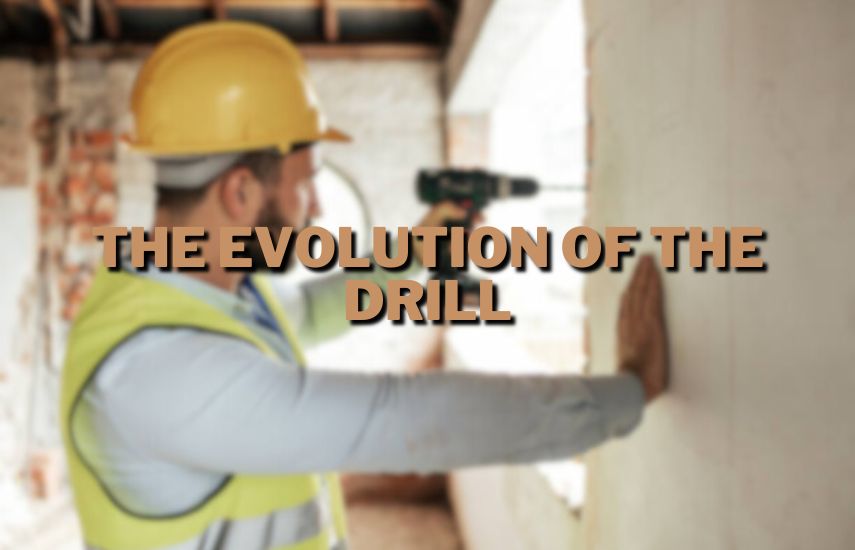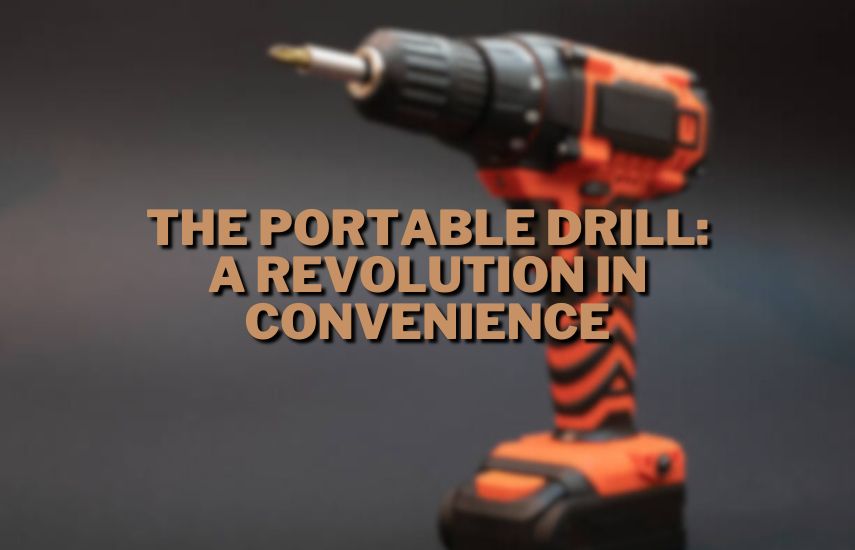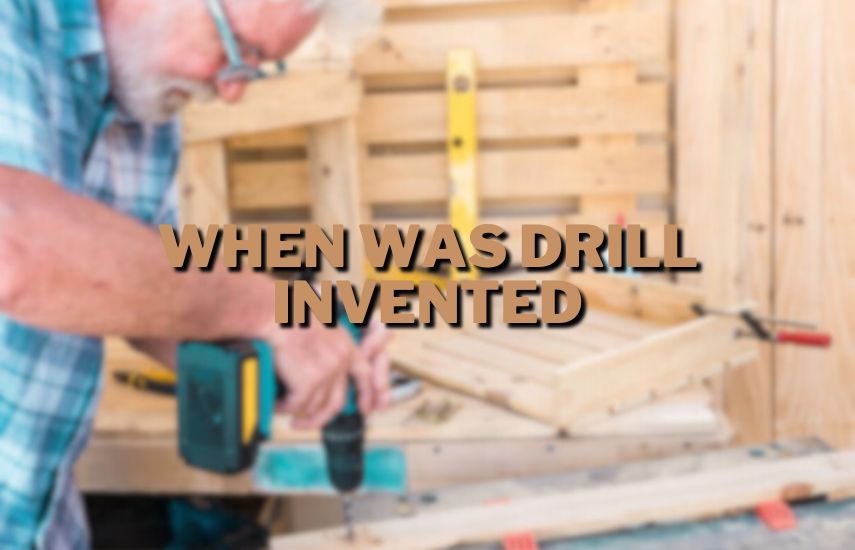Have you ever wondered when the drill, that handy tool we use for making holes or driving screws, was first created? Well, you’re in for an interesting journey through time! The invention of the drill is a fascinating chapter in human history. It’s a story of ingenuity and problem-solving that dates back thousands of years.
When Was Drill Invented? The concept of a handheld drill dates back to ancient times, with evidence of bow drills used by ancient Egyptians around 2500 BC. However, the modern electric drill we’re familiar with today was developed in the late 19th century, with various improvements over the years.
In this blog, we’ll delve into the origins of the drill, tracing its evolution from simple hand-cranked devices to the high-powered electric and cordless drills we rely on today. We’ll uncover the inventive minds behind its development and how this ingenious tool has shaped various industries, from woodworking to construction.
The Earliest Drills
In the vast tapestry of tool history, one invention stands as a testament to human ingenuity and its profound impact on shaping our progress – the drill. This seemingly simple yet ingenious device has played a pivotal role in our journey as a species.
Primitive Beginnings
Our voyage begins eons ago when our ancestors were still taking their first steps in the art of tool-making. It was a time when creativity met necessity, giving rise to the birth of the earliest drills.
These primal tools were rudimentary yet effective, consisting of sharp stones or bones attached to wooden sticks. These handheld devices found their purpose in tasks such as piercing holes in wood and shells, marking the dawn of drilling.
Ancient Egyptian Advancements
As our journey progresses, we arrive in ancient Egypt, a civilization known for its remarkable contributions to science and technology. Here, the drilling landscape saw significant advancement with the invention of the “bow drill.”
This ingenious tool comprised a wooden bow and a spindle. The operator, by rapidly rotating the spindle, gained the ability to bore holes in a variety of materials, including stone. This innovation unlocked new possibilities in craftsmanship and construction.
Ingenious Chinese Innovations
Further east in ancient China, a parallel development in drill technology was unfolding. During the Han Dynasty, the Chinese introduced the “brace and bit.” This device, with striking resemblances to the modern hand drill, featured a rotating handle and a bit.
The marriage of these elements bestowed precision and efficiency upon the drilling process, allowing for a myriad of applications.
Medieval European Evolution
Our voyage continues into medieval Europe, a time of cultural transformation and renewed interest in mechanical innovation. European craftsmen seized the mantle of drill improvement.
They introduced crucial modifications by incorporating metal gears and crank handles into their designs. These enhancements conferred greater power and control upon the drilling process, marking a pivotal milestone on the journey towards the drills we employ today.
Industrial Revolution Impact
As we journey towards more recent history, we arrive at the cusp of the Industrial Revolution, an era defined by rapid technological progress. The 18th and 19th centuries witnessed the advent of steam-powered and subsequently electric drills.
These monumental inventions ushered in a new era, revolutionizing industries such as construction and manufacturing. Mass production and infrastructure development became not only feasible but also transformative, shaping the modern world as we know it.
The Evolution of the Drill

Ancient Origins
The story of the drill’s evolution is like a journey through time. It all began thousands of years ago when our resourceful ancestors needed a way to make holes in various materials. They fashioned the earliest drills from sticks and sharp stones, a simple yet effective solution that marked the birth of this essential tool.
Egyptian Advancements
Moving forward in history, we arrive in ancient Egypt. Here, the drill received significant upgrades with the development of the “bow drill.” This clever device featured a wooden bow and a spindle, allowing for faster and more precise hole-making, even in tough materials like stone.
Chinese Ingenuity
Across the world, in ancient China, another chapter of drill evolution unfolded. During the Han Dynasty, they introduced the “brace and bit.” This design closely resembled the modern hand drill, complete with a rotating handle and a bit. This innovation brought efficiency and accuracy to drilling tasks, opening up new possibilities for craftsmanship.
Medieval European Refinements
In medieval Europe, during a period of cultural revival, European craftsmen made their mark on the evolution of drills. They introduced metal gears and crank handles, a significant advancement that increased power and control. These modifications paved the way for drills as we know them today.
The Industrial Revolution’s Impact
Fast-forward to the 18th and 19th centuries, and we witness the dawn of the Industrial Revolution. Steam-powered and later electric drills emerged, transforming entire industries. Suddenly, drilling became faster, more precise, and capable of mass production.
This era ushered in the modern age of drilling, shaping construction and manufacturing as we understand them today.
Modern Marvels
Today, we have an array of sophisticated drills, from handheld power drills to massive industrial machines. These modern marvels owe their existence to the creativity and innovation of countless inventors and craftsmen who have contributed to the ever-evolving story of the drill.
They have become indispensable tools in construction, manufacturing, and countless other fields, demonstrating how a simple idea has grown into something truly remarkable.
The Electric Drill: A Game-Changer
Revolutionary Invention
The electric drill, a marvel of engineering and innovation, has unquestionably revolutionized the world of tools and technology. Its profound impact spans across diverse industries and has even transformed our daily tasks.
Birth of Convenience
Prior to the electric drill’s arrival, drilling holes and driving screws demanded substantial physical effort and consumed valuable time. Traditional hand drills heavily relied on human muscle power, often leading to fatigue and inefficiency.
The electric drill changed the game entirely. With a simple push of a button, it introduced a level of convenience previously unimaginable in drilling tasks. This newfound ease made it accessible to both professionals and DIY enthusiasts.
Versatile Powerhouse
One of the electric drill’s hallmark characteristics is its unparalleled versatility. Equipped with various drill bits and attachments, it effortlessly handles an extensive range of materials, including wood, metal, and even unforgiving masonry.
This adaptability rendered it an indispensable tool across industries, from construction and woodworking to metal fabrication and beyond. The electric drill became the Swiss Army knife of power tools.
Precision and Speed
Beyond its convenience, the electric drill elevated precision and speed to the forefront of drilling technology. The controlled rotation mechanism facilitated pinpoint accuracy in hole placement, eliminating the guesswork that often plagued manual drilling.
Additionally, the ability to adjust drilling speed made it suitable for a diverse spectrum of tasks, from delicate crafting endeavors to heavy-duty construction projects. This level of precision and efficiency revolutionized craftsmanship and manufacturing.
Industrial Impact
The electric drill’s impact on industries extended far beyond convenience and precision. It played a pivotal role in propelling the rise of mass production and manufacturing during the 20th century.
Assembly lines became notably more efficient, leading to the widespread production of a vast array of goods, from automobiles to household appliances. The electric drill’s role as a driving force behind industrial progress cannot be overstated.
Everyday Convenience
While the electric drill initially made waves in industrial settings, it soon found its way into our everyday lives. DIY enthusiasts and homeowners eagerly embraced this tool for its ease of use and unmatched efficiency.
Home repairs, furniture assembly, and various improvement projects became more accessible and enjoyable. The electric drill transformed ordinary individuals into capable DIY experts, fostering a culture of self-reliance and creativity.
The Portable Drill: A Revolution in Convenience

The portable drill, a marvel of modern engineering, has truly transformed our lives, ushering in an era of unparalleled convenience and efficiency. This portable powerhouse has become an essential tool in various domains, from construction to DIY projects.
A Shift in Mobility
Before the advent of portable drills, traditional drilling tools were often bulky and tethered to power sources. The portable drill, with its compact design and battery-powered operation, marked a seismic shift in mobility.
Craftsmen and enthusiasts alike could now move freely without being bound by cords, making it ideal for jobs in tight spaces or remote locations.
Versatility Amplified
Portable drills didn’t just bring freedom of movement; they also amplified versatility. Equipped with a range of attachments and drill bits, they can tackle a myriad of materials, from wood and metal to concrete.
This adaptability rendered them indispensable in a wide spectrum of tasks, from minor household repairs to professional construction projects.
Battery-Powered Revolution
The introduction of rechargeable lithium-ion batteries took portable drills to the next level. These high-capacity batteries not only eliminated the need for constant power outlets but also provided extended usage periods on a single charge.
This game-changing innovation made the portable drill a reliable companion on job sites and around the house.
Precision and Ease
Portable drills didn’t compromise on precision either. Their ergonomic designs and variable speed controls allowed users to fine-tune drilling depth and speed, ensuring accurate and clean holes. This level of precision made intricate tasks like assembling furniture or installing fixtures a breeze.
DIY Empowerment
Perhaps one of the most significant impacts of the portable drill was its role in empowering DIY enthusiasts. With its user-friendly features and versatility, it allowed individuals to take on a wider range of projects without the need for extensive training or experience. Home repairs, woodworking, and craft projects became accessible to everyone.
The Drill Today: A Variety of Tools for Every Need
In today’s world, the drill has evolved into a diverse family of tools, each designed to cater to specific needs. From the traditional hand drill to sophisticated cordless electric models.
Traditional Hand Drills
The trusty hand drill, with its simple design and reliance on human power, remains a valuable tool for those who prefer manual control. It’s perfect for small tasks, offering precision and reliability without the need for batteries or cords.
Corded Electric Drills
Corded electric drills are workhorses that provide continuous power for heavy-duty tasks. They’re favored by professionals for their consistent performance and reliability. These tools are ideal for drilling into tough materials like concrete or metal.
Cordless Electric Drills
Cordless electric drills, powered by rechargeable batteries, combine mobility with versatility. They’ve become a staple in DIY projects, offering ease of use and convenience. Their lightweight design makes them perfect for a wide range of tasks, from assembling furniture to installing fixtures.
Impact Drills
For tasks that require more than just drilling, impact drills have emerged as the solution. With a hammering action in addition to rotary motion, they excel at tasks like masonry and concrete drilling, making them essential for construction and renovation projects.
Right Angle Drills
When space is limited, right angle drills come to the rescue. Their compact design and 90-degree angle make them perfect for tight corners and confined spaces. Carpenters and plumbers often rely on these specialized tools.
Specialized Drilling Tools
Beyond these common types, the world of drilling tools offers a range of specialized options. For example, magnetic drills are used for precise drilling in metal, while diamond core drills are essential for cutting holes in tiles or stone. These specialized tools cater to niche requirements across various industries.
The Future of the Drill: What’s Next?

As technology continues to advance, it’s natural to wonder what lies ahead for an everyday tool like the drill. The future promises exciting possibilities, with innovations that can further enhance the utility and efficiency of these indispensable tools.
Smart Drills
One of the most anticipated developments is the integration of smart technology into drills. Imagine a drill that connects to your smartphone, offering real-time data on drilling depth, speed, and battery life. Smart drills could provide tutorials, guide users through complex tasks, and even alert you when it’s time for maintenance.
Enhanced Portability
The trend toward smaller, more portable tools is likely to continue. Future drills may be even more compact and lightweight, making them incredibly easy to transport and maneuver in tight spaces. These tools may also feature improved battery technology for longer usage on a single charge.
Greener Power Sources
With sustainability becoming a global priority, drills may shift toward greener power sources. We might see the rise of solar-powered or energy-efficient drills that reduce environmental impact while maintaining high performance.
Advanced Materials and Durability
Future drills are likely to be constructed using advanced materials, making them even more durable and capable of withstanding harsh conditions. These tools could last longer, reducing the need for frequent replacements.
Safety Innovations
Safety features may take center stage in the drills of the future. This could include improved ergonomic designs to reduce strain on users and enhanced safety mechanisms to prevent accidents. Smart sensors might even detect potential hazards and provide warnings.
Specialized Drills for Specific Tasks
As industries become increasingly specialized, drills may follow suit. We could see the development of highly specialized drills designed for niche applications, ensuring the utmost precision and efficiency in fields like aerospace, medicine, or microelectronics.
The Drill: A Tool That Changed the World
The drill, a seemingly simple tool, has had a profound impact on the world. Its evolution and versatility have transformed industries, shaped civilizations, and simplified our daily lives.
Revolutionizing Construction
The drill’s role in construction cannot be overstated. It empowered builders to efficiently create holes, secure structures, and shape the modern skylines we see today. From towering skyscrapers to bridges and tunnels, the drill has been instrumental in constructing the world we know.
A DIY Game-Changer
Beyond construction sites, the drill made its way into households worldwide. DIY enthusiasts and homeowners embraced this tool for tasks ranging from simple repairs to crafting. It empowered individuals to take control of their living spaces and tackle projects with confidence.
Industry’s Right Hand
In industries like manufacturing and automotive, the drill is a trusted companion. Its precision, speed, and reliability revolutionized production lines, spurring industrial growth. This efficiency allowed for the mass production of everything from cars to appliances.
Innovation Through Versatility
The drill’s adaptability is one of its greatest strengths. From traditional hand drills to corded and cordless electric models, its evolution continues to meet the needs of various tasks and industries. Versatility is at the heart of its enduring relevance.
Pioneering Future Possibilities
The drill’s journey is far from over. With advancements in technology, we can expect even smarter, more eco-friendly, and specialized drills in the future. As we continue to innovate, the drill will remain a symbol of human creativity and progress.
Conclusion (When Was Drill Invented)
The invention of the drill dates back to ancient times, with the earliest known hand drills believed to have been created around 10,000 years ago by early human civilizations. Over the centuries, drills have evolved and mechanized, becoming the essential tools we use today for various applications.
In conclusion, the invention of the drill, a tool we now take for granted, dates back thousands of years to our resourceful ancestors. From primitive hand drills to the advanced electric and cordless drills of today, it’s a journey of constant improvement and innovation. The drill has evolved into an essential part of our lives, revolutionizing construction, empowering DIY enthusiasts, and boosting industries.
As we look back on its history, we can also look forward to a future where the drill continues to adapt, meeting the changing needs of our ever-evolving world. It’s a story of human ingenuity, making holes, and shaping progress.









